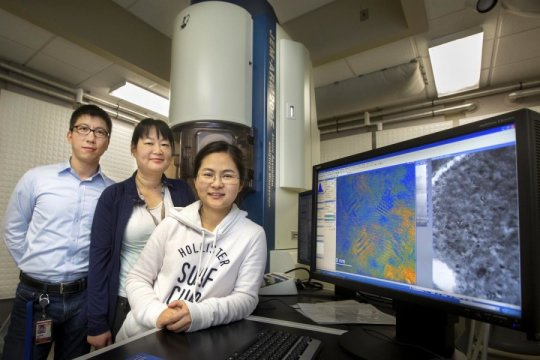[ad_1]
A team of Florida State University physicists has found a way to stabilize the color of light being emitted from a promising class of next-generation materials that researchers believe could be the basis for efficient and more cost-effective optoelectronic technologies that can turn light into electricity or vice versa.
The research is published in Nature Communications.
“This particular work is solving a critical problem that has inhibited the development of viable applications based on these materials,” said Assistant Professor of Physics Hanwei Gao.
Gao and physics doctoral student Xi Wang were working with a class of materials called halide perovskites. Researchers believe these materials have great potential for optoelectronic technologies because they are inexpensive to obtain and highly efficient. However, in these technologies, scientists need to be able to tune the bandgap or the color of the light emission. In halide perovskites this has been a bit tricky.
Color tunability has always been possible with halide perovskites, but it’s not been stable. For example, a device with this material might shine one color such as yellow, but then turn to red quickly if illuminated continuously by UV light.
“When you design it, you want it to turn out how you expect,” Wang said.
Added Gao: “If you buy a yellow light bulb, you’re not going to be happy if it is shining red after a few uses.”
Gao and Wang, together with their collaborators Yan Xin, a researcher at the National High Magnetic Field Laboratory, and Professor Shangchao Lin of Shanghai Jiao Tong University in China, discovered how to stabilize it.
But, it was almost an accident, they said.
Gao and Wang initially set out to make a higher-quality halide perovskite film that was smoother and more uniform than existing samples. They embedded nanocrystals in a special matrix in their sample. They were not prepared for this to affect the bandgap, or the physical property that determines the color of light being emitted or absorbed by the material.
“We were working on this synthetic approach and this nanostructure that was a part of that,” he said. “Then we noticed the colors weren’t changing.”
This unique nanostructure turned the previously unstable materials into extremely stable ones even when they are stimulated by concentrated UV light 4,000 times more intensive than the solar radiation.
Gao and Wang said they hope other researchers in the field will follow up on their work by examining further electrical behaviors with this composite structure.
Story Source:
Materials provided by Florida State University. Original written by Kathleen Haughney. Note: Content may be edited for style and length.
[ad_2]















